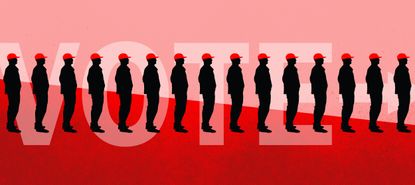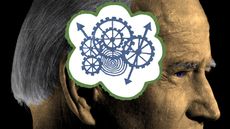Has Trump solved his biggest 2016 campaign problem?
His campaign seems more organized than in 2016. Democrats should be worried.


What does it mean to have record turnout in two early states when voters have no realistic option other than the incumbent?
In Iowa, 31,000 people trudged out into the evening cold to caucus for President Trump despite there being no real competition for the Republican presidential nomination. That was 6,000 more votes than Barack Obama got in Iowa for his 2012 renomination, and four times as many as turned out for George W. Bush's campaign in 2004. Trump's share was more than four times the number of Republicans who caucused during George W. Bush's 2004 re-election campaign.
Politico's Alex Isenstadt notes that "the vote totals in New Hampshire were even starker." Trump got nearly 130,000 votes, well over double what Obama and Bush got in their second-term Granite State primaries. Those relatively huge numbers for non-competitive contests took media analysts by surprise, especially since almost no attention had been paid to any efforts by the Trump campaign to organize for the primaries.
Subscribe to The Week
Escape your echo chamber. Get the facts behind the news, plus analysis from multiple perspectives.

Sign up for The Week's Free Newsletters
From our morning news briefing to a weekly Good News Newsletter, get the best of The Week delivered directly to your inbox.
From our morning news briefing to a weekly Good News Newsletter, get the best of The Week delivered directly to your inbox.
Isenstadt calls this "a warning sign for Democrats in November." At the very least, it indicates that Trump's turnout organization has learned something from 2016. And that might be curtains for Democrats' 2020 electoral hopes, both for the White House and in Congress.
Four years ago, Trump won the presidency largely on a turnout change — not among Republicans but among Democrats. Hillary Clinton lost hundreds of thousands of votes in the so-called "blue wall" states that had turned out for Obama in two straight elections. In Wisconsin and Michigan, Trump didn't change the GOP turnout at all, and only improved it slightly in Pennsylvania. Democrats won the 2018 midterms on the basis of better turnout and a lull in GOP enthusiasm, both of which they need to win the election in November. It looks like Democrats have actually fired up Republicans — and not just Trump's base, either — with impeachment and their hard lurch to the left.
It's still early in the process, and both Iowa and New Hampshire are relatively small states that stand alone in the primaries. Trump counterprogrammed against Democrats in both states with splashy rallies to energize his base on the eve of the contests, which might have driven those numbers higher. He will likely do the same in Nevada and South Carolina to compete with Democratic messaging and leverage the media focus on those states into enthusiasm and turnout.
That makes Super Tuesday on March 3rd a potentially good test of the Trump turnout machine and whether these are rally effects or a significant measure of Trump/RNC organization. Fifteen states will hold their presidential-preference contests on March 3rd, all primaries rather than caucuses, and Trump can't be in 15 places at once in the day or two before these contest. If he's still getting record turnout of Republican primary voters in those states, then Democrats had better be very, very worried, perhaps on the cusp of a full-blown panic.
Trump's biggest problem in 2016 was organization. He only adopted a traditional get-out-the-vote model late with the RNC, which had built its Republican Leadership Initiative (RLI) to operate independently of the nominee, a project on which I reported at length in my book Going Red. Democrats still have yet to adopt a similar approach, even after Clinton failed to turn out Obama's bonus voters in the blue-wall states, which was the main reason why Trump won the election.
The RLI has been rechristened the Trump Victory Leadership Initiative, but the question remains as to whether Trump has truly adopted its bottom-up granular approach to electioneering. These primary turnout numbers might be the first evidence of its success in two states that the RLI specifically targeted. Watch for Super Tuesday results from Colorado, Minnesota, North Carolina, and Virginia especially to check whether those GOP turnout numbers remain high. If so, then Democrats might need to hit the panic button — especially if their own turnout numbers remain pedestrian.
That applies to their down-ballot races, too, one of the main goals of the original RLI project. The RNC and the Trump campaign want to fire up their voters to reverse the loss of the House, and to protect the Senate while they're at it. Axios calls this "Trump's revenge," and that fits, especially given Trump's reluctance to do a lot of retail politicking ahead of the 2018 midterms. Fifteen months after losing the House, after realizing "firsthand how damaging a Democratic-led House has been to him, Trump is now personally invested in helping Republicans regain the majority in November."
It's not clear just what form that "investment" will take. Rallies do well to stoke Trump-voter enthusiasm generally, but a congressional campaign strategy has to choose its targets with precision and lots of local-style politicking. House Minority Leader Kevin McCarthy (R-Calif.) tells Axios that Trump plans to campaign more granularly this year, digging into the swing districts that flipped in 2018. That, however, is precisely the kind of politicking for which the RLI — now the TVLI — was designed.
All of this might be moot if Trump's incumbent re-elect primary vote tallies shrink back to the Bush or even Obama levels over the next few weeks, rendering Iowa and New Hampshire as little more than intriguing outliers. If these turnout numbers hold up after Super Tuesday, though, Democrats might have good reason to panic over their chances in November.
Want more essential commentary and analysis like this delivered straight to your inbox? Sign up for The Week's "Today's best articles" newsletter here.
Create an account with the same email registered to your subscription to unlock access.
Sign up for Today's Best Articles in your inbox
A free daily email with the biggest news stories of the day – and the best features from TheWeek.com
Edward Morrissey has been writing about politics since 2003 in his blog, Captain's Quarters, and now writes for HotAir.com. His columns have appeared in the Washington Post, the New York Post, The New York Sun, the Washington Times, and other newspapers. Morrissey has a daily Internet talk show on politics and culture at Hot Air. Since 2004, Morrissey has had a weekend talk radio show in the Minneapolis/St. Paul area and often fills in as a guest on Salem Radio Network's nationally-syndicated shows. He lives in the Twin Cities area of Minnesota with his wife, son and daughter-in-law, and his two granddaughters. Morrissey's new book, GOING RED, will be published by Crown Forum on April 5, 2016.
-
 Is pop music now too reliant on gossip?
Is pop music now too reliant on gossip?Talking Point Taylor Swift's new album has prompted a flurry of speculation over who she is referring to in her songs
By Richard Windsor, The Week UK Published
-
 Nuclear near-misses
Nuclear near-missesThe Explainer From technical glitches to fateful split-second decisions, the world has come to the brink of nuclear war more times than you might think
By Rebecca Messina, The Week UK Published
-
 What is cloud seeding and did it cause Dubai's severe rainfall?
What is cloud seeding and did it cause Dubai's severe rainfall?The Explainer The future is flooded
By Devika Rao, The Week US Published
-
 Arizona court reinstates 1864 abortion ban
Arizona court reinstates 1864 abortion banSpeed Read The law makes all abortions illegal in the state except to save the mother's life
By Rafi Schwartz, The Week US Published
-
 Trump, billions richer, is selling Bibles
Trump, billions richer, is selling BiblesSpeed Read The former president is hawking a $60 "God Bless the USA Bible"
By Peter Weber, The Week US Published
-
 The debate about Biden's age and mental fitness
The debate about Biden's age and mental fitnessIn Depth Some critics argue Biden is too old to run again. Does the argument have merit?
By Grayson Quay Published
-
 How would a second Trump presidency affect Britain?
How would a second Trump presidency affect Britain?Today's Big Question Re-election of Republican frontrunner could threaten UK security, warns former head of secret service
By Harriet Marsden, The Week UK Published
-
 'Rwanda plan is less a deterrent and more a bluff'
'Rwanda plan is less a deterrent and more a bluff'Instant Opinion Opinion, comment and editorials of the day
By The Week UK Published
-
 Henry Kissinger dies aged 100: a complicated legacy?
Henry Kissinger dies aged 100: a complicated legacy?Talking Point Top US diplomat and Nobel Peace Prize winner remembered as both foreign policy genius and war criminal
By Harriet Marsden, The Week UK Last updated
-
 Trump’s rhetoric: a shift to 'straight-up Nazi talk'
Trump’s rhetoric: a shift to 'straight-up Nazi talk'Why everyone's talking about Would-be president's sinister language is backed by an incendiary policy agenda, say commentators
By The Week UK Published
-
 More covfefe: is the world ready for a second Donald Trump presidency?
More covfefe: is the world ready for a second Donald Trump presidency?Today's Big Question Republican's re-election would be a 'nightmare' scenario for Europe, Ukraine and the West
By Sorcha Bradley, The Week UK Published